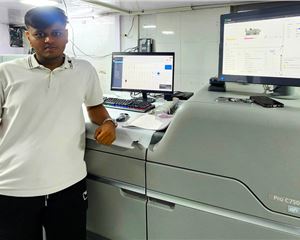A segment, which registered 20% growth in volumes during 2008 to 2011, suddenly stagnated. Why was it such a short bubble? Is the segment being buffeted by the affordable older technologies? Or print buyer apathy?This Sunday Column, Naresh Kumar of Macromedia and Bhagawath Prasad of Printech talk about how a mature and sensitised market could be riding the answers to growth
This year’s Fespa show was a great showcase for wide-format printing. It was bigger than the previous edition in London and explored emerging market opportunities, from textile to interior design to 3D printing and decals to focusing on eco-friendly inks and materials.
While it saw screen printing now focus on industrial applications such as membrane switches, smartphones, glass printing and decals, wide-format printer manufacturers successfully displayed a wide range of applications.
This success has raised the expectation for the big wide-format show in India – the Media Expo New Delhi 2015.
But how have the last few years been for the Indian wide-format industry?
The general feedback has been:
1. The Print volume (billboard / in-shop / signage) has not grown the way we saw, 20% growth in volume from 2008-2011;
2. The print volumes have decentralised, in-shop branding has not seen much growth, signage and other new applications like LED slim light box and branding exercise;
3. Telecom, banking and entertainment has reduced their budget exposure to the segment;
4. Rental and other street furniture space cost-to-hire has also not levelled up and is still very high.
On the printer placement size:
1. High-end systems (UV/solvent/ latex) installation remains in single digit. For example, Gandi has placed two systems, EFI placed two systems, HP placed their 10000 in Delhi and a couple of Latex 3000. That makes it a very few installations;
2. Mid-range systems from Fuji, Canon and Dilli also saw a few installations (these are for systems that are costing in excess of USD 75-100 thousand);
3. The mid-range systems that include the latex range, mid-level flatbeds, UV LED printers for in-shop branding saw 10-20 installations that cost between USD 35-60 thousand range;
4. The bottom end of the market that includes the Chinese systems, systems from ROLAND and other players saw a good installation base. For an example, a 10ft solvent printer in range of Rs 10-15 lakh range has seen 200 printers installed in one year;
5. Printers between Rs 8-11 lakh must have seen additional 150 printers installed.
6. Eco-solvent Chinese printers must have been more than 250 printers and branded product like Latex L 25500/ Roland/ Mutoh must have combined installed over 100 printers in the last one year.
The emerging market trends are:
1. Print service charges are continuing to fall;
2. Cost of material has gone up slightly, the costs of other consumables like inks have reduced or alternative ink suppliers have emerged;
3. Creditworthiness of printers have waned, and many printers have closed down operation;
4. Printer installations have gone from tier 1/2 cities to Towns/ smaller locations (for example, one company has over 50 printers installed in all categories);
5. The established PSPs have avoided new investment because of lack of volume traction and margins.
The two talking heads
I happened to meet two of the biggest wide-format players recently, B Prasad of Printech and Naresh Kumar of Macromedia Digital Imaging, who shared with me their take, concerns and challeng
es in the segment.
I asked, why is there a lull in high-end investments?
“The large companies like HP, EFI, Agfa have stopped manufacturing solvent machines because there is nothing for them in such machines. Similarly, the Chinese machines have invaded the sector, with improved quality, and taken away the businesses of these companies,” says Kumar of Macromedia.
Prasad adds, “The cost of prints of these high-end machines are so high that the end-users are forced to use solvent.”
Any why not? These Chinese machines have matured and sold at a very affordable price. And they suit the market very nicely. “The solvent machines have been working fine, even if they are ten years old,” say Prasad.
The big daddies (HP, Agfa, EFI) did not anticipate this scenario.
The other reason for the low investment in high-end machines is that the campaigns for products by brands have shortened their duration. “During the introduction of the telecoms, the campaigns used to run for three months, now it has dropped down to about a week. In that scenario, why do you need a high-quality print. Hence, customers opt for solvents.”
Whereas in a place like China, they are doing pretty well; their in-shop requirements have risen sharply. “As a result, in China you have about 15 UV installations, as against three or four installations in India,” says Prasad.

EFI is among the UV installations. Agfa has not been able to penetrate the Indian market with its Annapurna. And the Canon Arizona is a very good quality machine, it is a very slow machine. “It’s perhaps a good machine for photo-quality jobs but not for volumes,” says Prasad.
Last year Macromedia did a campaign for Google in 29 cities. It changed the campaign every single day, for 14 consecutive days. Naresh laments that he sometimes has to replace one company’s branding with another. “Sometimes the artwork of the billboard, the advertisements in the newspapers, etc are all the same. It’s like promoting one brand a day.”
In such a scenario, he says whether it is a high-end UV or a solvent machine print, it does not matter. “What matter is the correctne
ss of the visual.”
Offset moving to wide-format?
Roland DC recently published a white paper - Going Wide Understanding the Opportunities in Wide-Format Printing, authored by Richard Romano, the senior analyst at WhatTheyThink. The abstract reads, “Over the past 15 years, the commercial printing industry has been adversely affected by decreases in the overall demand for print. One bright spot, however, where demand for print is increasing, is wide-format graphics. As a result, commercial printers have been looking to wide-format as a potential new business opportunity.”
In the West and even so in Australia, the wide-format sector has become very popular. Not surprisingly, at Fespa all the high- and middle-range wide-format printer manufacturers sold lots of machines.
But that has not happened in India and according to Prasad is not likely to happen in a hurry.
Prasad says, “Offset is volumes game. And by the nature of the business, its characteristics is longer runs that will make profits. Those who cannot cope up with the characteristics of the offset business will take a second look at his business.”
Even then, he says, the offset player may opt for the short-format digital rather than wide-format. “When you play in such a
high-volume offset line, the bandwidth of the converters is completely occupied with running that business. They don’t have the time to think about anything else.”
While in the West too, he agrees, it’s a volume game. He argues that, unlike in India, the wide-format there is close to the offset line.
“Take, for example, Starbuck campaign. Starbuck perhaps spends about USD 10mn in a year. When one particular campaign breaks out, the short-format poster as well as the wide-format poster goes out in equal numbers. So it makes more sense for a printer there to supply both the offset as well as the wide-format variants. The whole model of offset and wide-format business is different there.”
Wide-format business – gathering steam?
Players like Macromedia and Printech, along with others in the top 10, are doing well volume-wise but because of the shrinking margins, the profits are perhaps dropping, and that’s a bit of a worry.
“Overall, the market sentiments this year seems to be better than the last year. Though we did better in the last year and the year before that too. But this year seems more upbeat,” says Prasad.
Kumar says about two-and-a-half years we consciously decided not to work with middlemen, instead work closely with the end user. “We did take a hit in our overall business. But we have managed to come around.

Last year was one of the best years in terms of overall financial performance. It gives an indication that we are on the right track.”
He adds, “This year, it has been good so far. My clients are pushing us to do more.”
What are the trends they think the industry needs to pursue?
Fabric and textile. “If you look at the in-shop brandings in India, it’s foam-board, vinyl boards broken, etc. Many of our customers talk about Apple stores, where there are no foam boards or vinyl, just seamless display. One does not even realise that there is fabric in the frame. My clients are coming back and saying we need to do something like this,” says Kumar.
Textile earlier had a limitation on the technology front to print. For example, earlier it used to be done through transfer, which is a cumbersome process. The investment is high and is not conducive to the Indian market. But now, if you see, there are small printers in the bracket of Rs 5-lakh with heat-transfer built-in. And to achieve higher and superior print, there are the latex types of technology that can grow that market. Then there is UV curable printing for textile, where you can do multiple layered printing on textile.
Kumar gives an example of innovation in fabric. “There is a German company that makes sound-proof clothes that can be used to make cubicles. It’s all about putting such textile applications to use. The material comes in white colour, but nobody wants just a white partition, they would rather have some print on it.”
We need to have more campaigns like the Magnum chocolate. After a long time, we have seen a campaign of this scale. “Yes, that’s a good sign,” says Prasad.
The other aspect of wide-format that is a concern and can well turn into a boon is the environmental concern. There is a lot of activism in terms of 'outdoor is bad, flex has to be banned.' We all know solvent is a DG3-rated good. It is not good for human health and safety. Once the visual is put up, over a period the solvent gets evaporated and mixes with the air.
“The market needs some maturity, like the green campaign that is going on. We have tried to push recyclable material. But the cost in India is a bit of a concern because the volumes are quite large. Environmental concerns take a back seat because of the cost economics,” says Kumar.
Also, a lot of players in this unorganised sector get away with things like not abiding by government regulations on tax, employee payments, using cheap material, etc. Both Kumar and Prasad say that the end-user should also get the kind of sensitivity, which will drive better practices in the segment.
And once the kind of maturity and sensitivity that is being spoken about, comes to the market, the scene will change, says an optimistic Prasad.
So as we move into the rest of the year, there are indications that the established players in the wide-format segment are open to facing the challenges. The brand manager on their part will have to break away from the traditional ways of dealing with print and bring in the required maturity and sensitivity that will help the segment blossom again.














 See All
See All